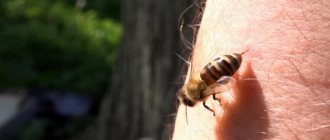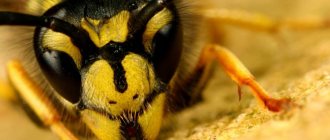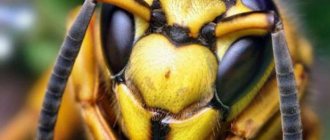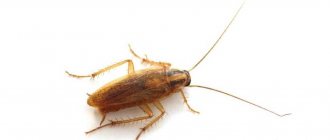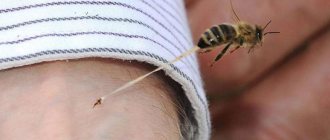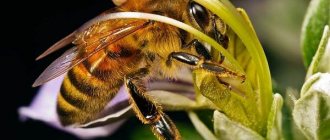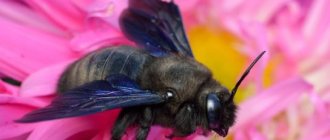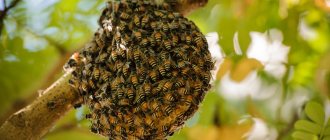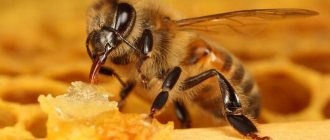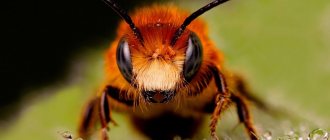What you need to know about hornets and bees. The war between insects, why this happens. How bees resist a huge enemy and what methods of defense they use. How can they kill a hornet? Other enemies of hornets. Which insects become their victims?
Many of us consider hornets to be true predators and are confident that these large insects are waging a real fight against honey bees. A lot of information that is presented for general viewing does not show hornets from a very good side, where one individual can easily withstand tens and even hundreds of bees, while destroying them.
There is some truth in this; a few hornets can really completely destroy a bee colony. But you shouldn’t take everything the way it is presented. In fact, there is no war between them, and the hornets do not want to destroy their population at all, everything is much simpler and more banal. You just need to get to know these insects a little better.
Hornets vs honey bees
It will not be a revelation to anyone that these bright and huge insects have long been labeled “killers”; this statement, of course, applies to insects. But this label was assigned not entirely fairly, even, one might say, incorrectly. They do kill other insects, but this is a kind of hunting and not for fun, but for the sake of feeding their offspring.
Nature has decreed that in order to continue the population, they need to regularly go hunting and get new food to bring to the nest and feed the offspring. It is not their fault that their diet consists of other insects.
And the point is not at all about bees; they, like other insects, simply serve as food for their family. It is worth saying that they even hunt small frogs, since nature has awarded them with strong and large jaws.
Having figured out why they kill insects, you can understand that they received the title of killers completely undeservedly, because in this case this title can be assigned to ants. After all, goosebumps also constantly bring home bugs, larvae, caterpillars and other insects, but no one labels them “killers.” Perhaps the reason is that the struggle of a hornet is much more spectacular than that of an ant.
It is worth saying a few words about why hornets choose beehives. In fact, in this matter everything is very clear and simple - this is an ideal feeding place. A large number of individuals gather in this place and they are easy to catch, which reduces the time spent searching for food.
It is also a valuable nutritious product, which is important. Well, one more important point: there is always the opportunity to enjoy honey, and the diet of adults consists mainly of sweet foods.
How one can understand the choice of bees as a hunting object is completely understandable. The presence of at least one hive in the hornets’ habitat provides the entire colony with adequate nutrition, and they obtain food without much effort.
You should not think that they specialize in killing bees; they hunt completely different insects, but they will not refuse such healthy food, especially if the hive is nearby.
Preventive measures
An experienced beekeeper knows that keeping bees healthy and in good condition is the key to successful beekeeping. Therefore, he always monitors the behavior of his charges in order to take timely measures when dangerous pests are detected. Regular preventive measures help maintain successful beekeeping:
- keeping only strong bee colonies;
- sufficient provision of bees with food and warmth;
- periodic cleaning, drying, ventilation and repair of hives;
- drying insulation in the sun;
- lubricating the legs of the houses in grease or kerosene;
- installing an apiary away from water and anthills;
- periodic disinsection of insulating material;
- treating hives with sulfur dioxide;
- installation of special barriers or nets on the tapholes to prevent the penetration of pests;
- mowing grass under houses.
Advice ! Regularly walking around the apiary area in search of unwanted holes, nests, insects and pests is also considered a preventive action against harm to bee colonies and beekeeping in general.
Hunter and prey: hornet and bee
These insects belong to the same order of Hymenoptera, which also includes wasps, bumblebees, as well as riders and ants. All of them are united by certain behavioral features, as well as similarities in appearance. In addition to some similarities, there are also many differences.
So, we all know about the presence of a poisonous sting in hornets, wasps, bees, and bumblebees. Regarding ants, the tropical species has a sting and it is worth saying that their bite is the most painful. The poison of each of the representatives is toxic, dangerous to humans and has similarities in its composition.
Despite the similarity, the poison of each representative has characteristics that are decisive at the moment of impact on the human body. What this means can be seen with an example.
Hornet venom has a stronger effect on nerve receptors than others; it has a high level of allergenicity. Bee venom is different in that they release a large amount of toxin at one time, which causes severe poisoning.
It is worth saying that different species have different poisons. For example, the common hornet, which is familiar to us, is capable of inflicting a very painful bite, but its poison will not cause serious consequences, unlike the poison of the giant Asian hornet, which is one of the most dangerous representatives on Earth.
Regarding hunting their victims, in this case they do not use poison, as you might think, they use no less dangerous strong jaws. It is also worth noting that hornets are very smart and cunning, this can be seen if you consider the hunting process.
They do not attack their victims who are alone. After all, it would seem that a bee that is busy collecting nectar is very easy prey, but they do not attack them. Cunning predators watch their prey so that it leads them to their hive, and then return to it in large numbers.
In order to completely destroy a bee hive, a different number of attackers is required and this directly depends on the type of predator. But this rule has its exceptions.
If we consider the behavior of the European species, then several hundred of these individuals are capable of destroying a hive in which there are about 10-15 thousand bees. But this is theoretical, since in practice the situation is somewhat different.
The fact is that in our country it is very rare for families of hornets to reach such large sizes. For this reason, in rare cases they can attack entire hives, and more often attack single bees. But such attacks also cause great damage to apiaries.
But if we talk about their giant relatives, Asian murder hornets, whose size is 2 times larger than European ones, really pose a great danger. Unfortunately, bees are absolutely helpless against this species. Let's look at this view in more detail.
Feathered
The death of bees is not only the result of insects. Birds are also not averse to feasting on striped “hard workers”. Not all species prefer to hunt bees. However, it is the birds that cause the greatest harm.
European bee-eater
Golden bee-eater
The golden bee-eater is a small bird that attracts visitors with its bright plumage and large beak. It seems to be a cute and beautiful creature. But behind the beauty lies the terrible gluttony of this bird. One bee-eater can destroy approximately 1 thousand insects daily.
European bee eater
Representatives are distinguished by their two-tone brown color. The size of the bird is about 60 cm. They hunt in flocks, attacking bees in the opposite direction, destroying them in large numbers.
Gray Shrike
Gray Shrike
The Gray Shrike eats mainly pollen collectors. Its length is approximately 30 cm, the color is dark gray with white accents on the abdomen and shoulders. Birds settle close to the apiary.
Giant hornets and their hunt
The undoubted difference between these huge insects, and at the same time their superiority over their relatives, is their size. They reach more than 5 centimeters in length; to understand how large these are, you can compare them to a worker bee, which is 3 times smaller. They attack their victims with powerful jaws; one movement is enough to break the joint of the chest and head, which leads to paralysis of the bee.
For a bee hive, they pose a huge danger, since in 1 minute just one predator can kill about 30 bees, and in order to destroy a hive of thousands, 30-40 predators are enough, which will deal with it in a few hours.
Hornets have a very hard chitinous body cover and it is practically invulnerable to bees, there are only a few places where they can pierce it with their stings, but even in this case, they will not cause much harm to the predator. In turn, predators very rarely use their stings.
In fact, for hornets, finding a hive and destroying it completely is a “tidbit,” so they do it with great pleasure. It is worth saying that the war between these insects was not started by nature, it was provoked by man and it is he who is to blame for the active extermination.
Bees' capabilities: defense is their secret weapon
Speaking about the types of these insects, it is worth understanding that some of them have never waged war with each other and do not even suspect the existence of relatives, and all for the reason that they live in completely different territories. For example, the Asian hornet, which lives in Southeast Asia and Japan, will not meet with the European honey bee, which lives in the Middle East and Europe.
But there are also Asian bees that use a rather original method in the fight against their relatives; it was developed in the course of joint evolution. So, when a predator is preparing an attack, the victims attack him themselves and in this case take advantage of the advantage of numbers. They cling to it from all sides, potential victims form a huge ball with a diameter of up to 30 cm, while each bee actively flaps its wings.
It seems that they cannot cause much harm to their enemy, but in reality this is not the case. The fact is that from such flapping of the wings, the temperature of the air inside the ball begins to rise.
In addition, the movement of the wings directs the heat to the center of this ball, where the enemy is located. A temperature of 46-47° is lethal for a predator, so it can stay in the middle of the ball for a maximum of an hour and then die. The owners of the nest can normally tolerate temperatures up to 50°, so they will not be harmed in any way.
For one such ball, about 500 bees are needed and the enemy is defeated. If we talk about a family, which on average consists of 15-20 thousand individuals, they can easily withstand 30-35 predators. This cunning method of defense is very reliable and effective against your enemies.
But European bees that live in our country do not use such a defensive method. This is due to the fact that hornets attack honey beehives in the wild very, very rarely, almost never, so there was no reason to develop such behavior.
But our bees can boast of another feature, namely the ability to collect large amounts of honey. Japanese beekeepers are trying in different ways to breed them in their territories where there are giant predators.
As mentioned above, war between relatives is not a natural phenomenon; it was provoked by man. The attempts of Asian beekeepers are unsuccessful, since predators destroy the hives they find, and the bees simply do not know how to protect themselves. It is not for nothing that nature has divided the species of these insects, and forced relocation leads to the death of a large number of insects.
Which butterflies are the enemies of beekeepers?
Large and small wax moths are nocturnal moths, and it is not the butterflies themselves that cause harm, but their caterpillars. They are the main enemies of bees. The large wax moth is a butterfly about 20 mm long, with a wingspan of 30-35 mm.
Interesting materials:
How to make a GIF from a video in a telegram? How to make a GIF from a photo on iPhone? How to make a gif in WhatsApp? How to make hyperlinks in Word 2010? How to make a hyperlink to another sheet in Excel? How to make a hyperlink to a Word document? How to make a hyperlink to a website in a presentation? How to make a paper garland in the shape of snowmen? How to make a gyroscope on your phone? How to make a histogram in Word using a table?
Hornets against bumblebees and other insects
It’s worth saying right away that for a hornet, any insect that is inferior in strength and has a smaller size is considered as a potential victim, and the bumblebee is no exception. Just like a bee, a bumblebee is defenseless against this predator, the only difference is that killing this victim will require a little more effort.
But the types of insects are also important here, since an Asian one can attack a bumblebee without hesitation, but a European one is unlikely to attack, for the reason that it will most likely be frightened by its size. They are approximately the same size and it is very difficult to say which of them is stronger, but there is a very high probability that the bumblebee will still survive.
It is a completely erroneous opinion that these insects are enemies. Here, rather, nature brought them together and forced them to tolerate each other. The bumblebee, by its nature, is very peaceful and is not a predator, so an attack on its part is out of the question. But at the same time, he is a large insect, which at the right time will give a worthy rebuff.
Let's find out how relationships with other insects develop:
- Wasp. Also considered as a victim, she is comparable in relationships and in the process of hunting with a bee, since she is defenseless in front of him. Their nests are attacked only in rare cases; they are also predators and, gathered in large groups, can fight back.
- Mantis. This insect cannot resist its opponent in any way; it is absolutely helpless. All he has are powerful legs, but they cannot harm the enemy in any way. When attacking a praying mantis, the hornet does not use its sting, there is no need for this, it simply bites through the joint in the neck area.
Who will lose in battle?
As we learned above, the hornet is able to attack certain insects, knowing that it will win. But there are insects that act as aggressors towards it. So, the hornet has a rather complex relationship with spiders, let’s learn about them in more detail.
First of all, it is worth saying that a spider can act in these relationships both as a killer and as a victim, much depends on their species. If we talk about spiders that hunt victims without using webs, for example, jumpers, small tarantulas, haymakers, when they meet a hornet they will die, thanks to its powerful jaws.
The web of a cross spider is a completely different matter; for humans it is safe, non-toxic and not very large in size, but for a hornet such an encounter will most likely end in death.
Let's take a closer look at the relationship with the tarantula spider; in this case, the chances of winning are almost equal. The fact is that they have almost the same size, both rivals are quite strong, and both have poison, but in the tarantula it is many times stronger, so the one who first inflicts a fatal bite has a greater chance of winning.
Now let's look at our closest relatives, namely stray ants and road wasps. Despite the fact that hornets act as predators in this case, there is a high probability of ending up as a prey when meeting them. The wasp has a powerful weapon - deadly poison, but the ants defeat it due to their numbers; they never attack alone.
The hornet also has a biological enemy, a unique fungus that develops in its brain. Fungal spores enter the insect’s body through the respiratory tract or through the mouth, and begin to germinate in the head; the development of the fungus leads to the fact that the insect begins to constantly feel thirsty. The hornet begins to look for water, when the source is found, the mushroom causes paralysis. The victim freezes in one position and then dies.
The death of a hornet, no matter how strange it may sound, gives life to a new organism, albeit a completely ordinary one. The dead body becomes a place for the fungus to grow and a place from which new organisms spread.
The list of hornet enemies does not end there, because they are also found among vertebrates. Let's find out in more detail who is on this list:
- Bee-eater birds. Their favorite food is bees and wasps, and they know how to catch hornets in such a way that they cannot bite. Afterwards, they smash the insect against a stone and swallow it, so that it does not cause harm to health. Other birds can feed on hornets in the same way.
- Human. It is the hornet's largest and most dangerous enemy and can kill hornets in huge numbers without much effort.
- Small parasites. Other enemies are nematodes, mites, and parasites, which are very difficult to destroy.
